IAMSE Manuals is a publication of the International Association of Medical Science Educators (IAMSE). The IAMSE Manuals offer all who teach in healthcare the most current information to succeed in their task by publishing short “how-to guides” on a variety of topics relevant to medical education. The publication of these manuals is overseen by the IAMSE Publications Committee.
How to buy a manual?
The IAMSE Manuals are published by Springer and can be purchased as eBook as well as hardcopy. Please visit their website at https://www.springer.com/series/16034 for more information. IAMSE members can purchase the electronic version at a discounted rate through the members-only area of the IAMSE website.
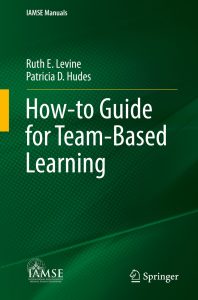 How-To Guide for Team-Based Learning
How-To Guide for Team-Based Learning
Ruth Levine, Patricia Hudes
To purchase an electronic or softcover version of this manual, click here to visit the Springer site.
The purpose of this manual is to provide the reader an overview of the fundamental components of Team-Based Learning (TBL) and its advantages over conventional instructional methods. It serves as a blueprint for instructors who wish to begin teaching TBL in a course or curriculum and it identifies factors that will facilitate or sabotage a successful implementation of TBL.
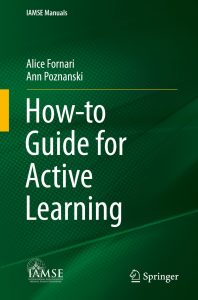 Active Learning Manual
Active Learning Manual
Alice Fornari, Ann Poznanski
To purchase an electronic or softcover version of this manual, click here to visit the Springer site.
This manual is a compilation of teaching strategies in active learning to adapt to your own large group settings.
Each chapter is a specific description of a strategy written by authors who are experienced in using the strategy in a classroom environment with students. The Manual chapters are designed to be accessible and practical to the reader. The manual is edited by Alice Fornari and Ann Poznanski.
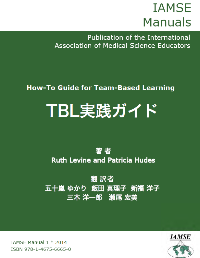 How-to-Guide for Team-Based Learning: Japanese Translation
How-to-Guide for Team-Based Learning: Japanese Translation
Ruth Levine, Patricia Hudes
Translated by: Hiromi Seo and Yoichiro Miki
This “How-To” Guide for Team-Based Learning is a manual that provides an overview of the fundamental components TBL and serves as a blueprint for instructors considering using this technique. The manual also identifies factors that will facilitate or sabotage a successful implementation of TBL. Authored by Ruth Levine and Patricia Hudes, both internationally recognized experts in the field of TBL. This Japanese translation was translated by Yukari Igarashi, Mariko Iida, Yoko Shimpuku, Yoichiro Miki, and Hiromi Seo.
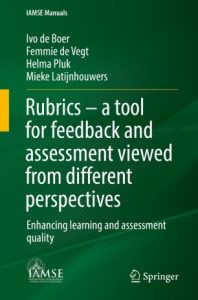 Rubrics – a tool for feedback and assessment viewed from different perspectives
Rubrics – a tool for feedback and assessment viewed from different perspectives
Ivo de Boer, Femmie de Vegt, Helma Pluk, and Mieke Latijnhouwers
To purchase an electronic or softcover version of this manual, click here to visit the Springer site.
This IAMSE Manual describes how to use rubrics in higher education, especially in the highly specialized health sciences education setting. The book provides a conceptual framework, practices and a series of checklists that lecturers can use to design their own rubrics for a variety of situations and content. It highlights varying perspectives, from teachers, students, educational advisors, and curriculum managers, while providing practical tips for developing and using rubrics.
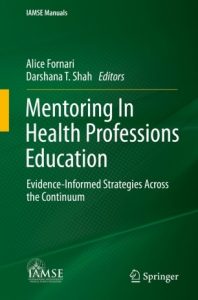 Mentoring In Health Professions Education
Mentoring In Health Professions Education
Alice Fornari and Darshana T. Shah
To purchase an electronic or softcover version of this manual, click here to visit the Springer site.
This IAMSE Manual, Mentoring Across the Continuum, is a product of its co-editors’ and authors’ lifetime work in mentoring faculty and studying the impact of this mentoring. The book defines the field of academic medicine as highly dependent on finding and relating to mentors at virtually every stage of a doctor’s career. It describes and analyzes successful mentor/mentee relationships, examining the authors’ personal experiences, as well as a data-driven approach, to explore the many different roles and perspectives on mentoring relationships and ultimately the mentoring culture. The editors look at the data with respect to the success of different strategies in mentoring, as well as different structures of diverse mentoring programs. As well, proven ways to deliver these programs successfully for all professionals who lead mentoring programs or are active participants as mentees.
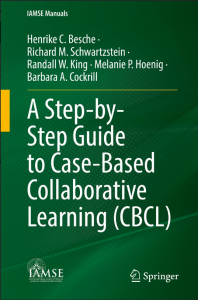 A Step-by-Step Guide to Case-Based Collaborative Learning (CBCL)
A Step-by-Step Guide to Case-Based Collaborative Learning (CBCL)
Henrike C. Besche, Richard M. Schwartzstein, Randall W. King, Melanie P. Hoenig, and Barbara A. Cockrill
To purchase an electronic or softcover version of this manual, click here to visit the Springer site.
This book is about Case-Based Collaborative Learning (CBCL) for medical educators. CBCL combines elements from team-, case- and problem-based based learning using a flipped classroom model. This book presents a detailed “how to” guide on how to create CBCL classroom materials, how to facilitate vivid discussions, and how to support students and faculty in a CBCL curriculum. The first chapter explores the CBCL method in context of established educational principles. The second chapter provides a step-wise guide to creating CBCL teaching materials from scratch or adapting existing resources. Chapter three discusses how to support both – faculty and students – in making the most out of in-class case discussions. The last chapter explores modifications to the CBCL method that have evolved over time in adapting to teaching remotely, as well as promoting self-directed learning skills in students. While originally developed in context of undergraduate medical education, the CBCL method is of interest to anyone in higher education that values flipped classroom methods and discussion-based teaching.
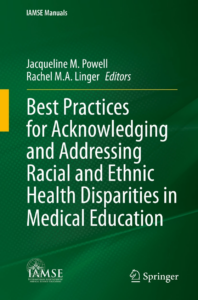 Best Practices for Acknowledging and Addressing Racial and Ethnic Health Disparities in Medical Education
Best Practices for Acknowledging and Addressing Racial and Ethnic Health Disparities in Medical Education
Jacqueline M. Powell and Rachel M.A. Linger
To purchase an electronic or softcover version of this manual, click here to visit the Springer site.
This manual is an instructional guide to provide healthcare educators with best practices for acknowledging and addressing racial and ethnic health disparities (REHD) in medical education. As a collaborative effort written by both medical students and educators, this manual examines the impact of race, racism, and ethnic biases on medical care and health outcomes.
This book enables readers to understand and apply key terms encompassing health disparities, bias, and cultural humility as an approach to demystify stereotypes, social assumptions and long-held misperceptions that influence the misuse of race in medical teachings. By examining the construct of race, differences between race-based and race-conscious medicine are distinguished. As such, medical educators will be guided to consider the effects of socioeconomic differences, environmental factors, and institutional racism between population categories with regard to healthcare compliance and outcomes.
Supported by evidence-based recommendations, this manual provides medical educators, curriculum managers, and institutions with strategies and checklists to improve their medical curricula to ensure a well-defined understanding of race and ethnicity in medicine. This book serves as a resource for medical educators and students as they aspire to become more culturally competent, equity-minded, and inclusive healthcare professionals.
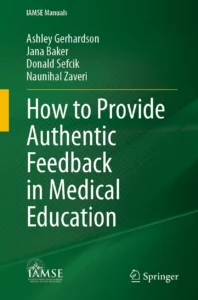
How to Provide Authentic Feedback in Medical Education
Ashley Gerhardson, Jana Baker, Donald Sefcik and Naunihal Zaveri
To purchase an electronic or softcover version of this manual, click here to visit the Springer site.
- Demonstrated how to share authentic feedback in medical education.
- Includes very practical applications and a 360-degree review with evaluations.
- Provides information for administration, faculty, students, and other key stakeholders.
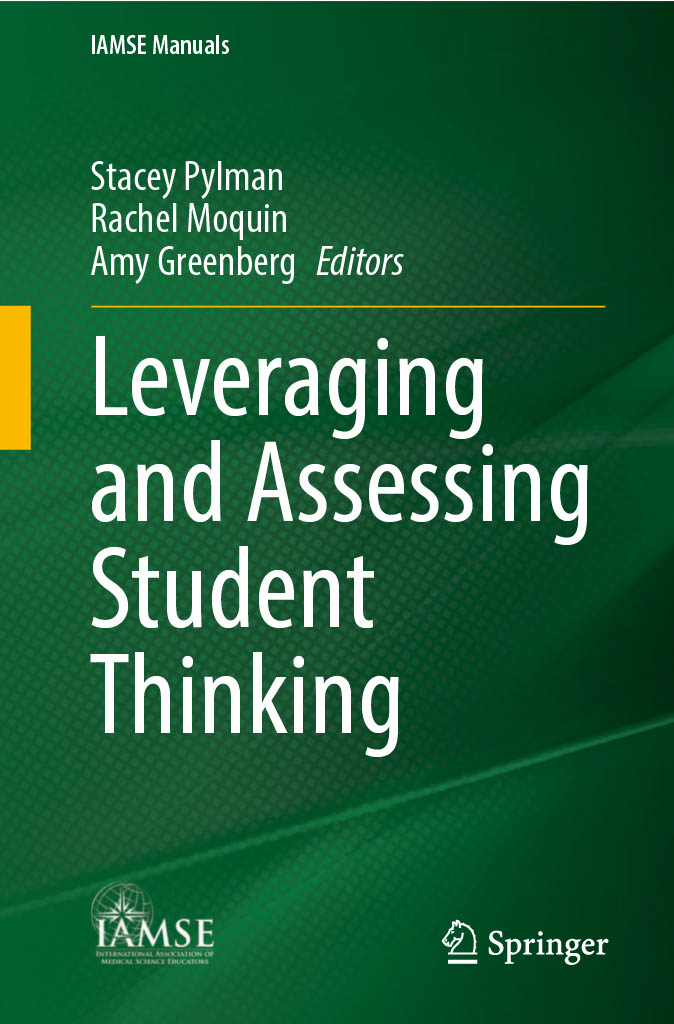
Leveraging and Assessing Student Thinking
Stacey Plyman, Rachel Moquin, Amy Greenberg
To purchase an electronic or softcover version of this manual, click here to visit the Springer site.
- Examines eliciting and interpreting student thinking in medical education
- Helps medical educators practice what it means to teach in a learner-centered way by leveraging student thinking
- Provides practical examples of how to elicit and interpret or assess student thinking
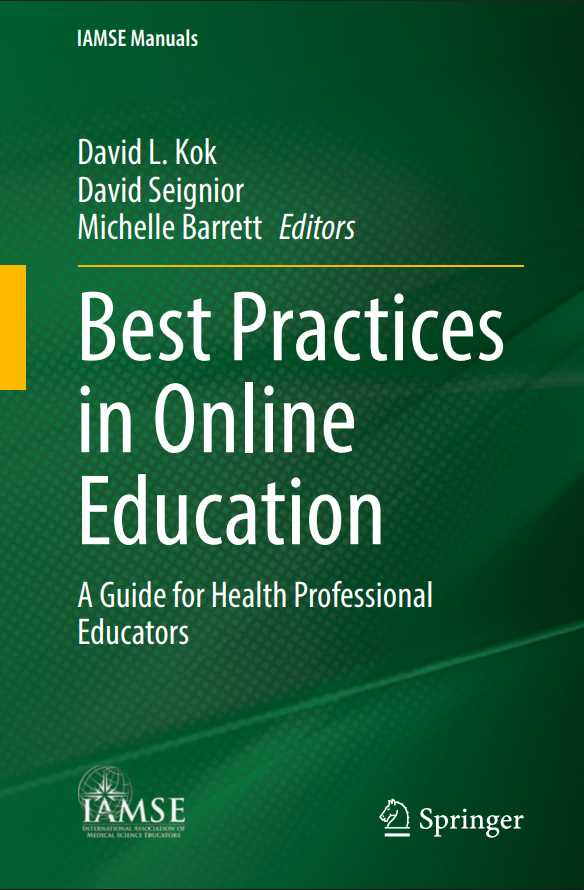
Best Practices in Online Education
David L. Kok, David Seignior, Michelle Barrett
To purchase an electronic or softcover version of this manual, click here to visit the Springer site.
- Succinctly curates wealth of online learning theory
- Frames all material in a multidisciplinary, holistic, and learner-centered lens in accessible prose
- Includes tips gleaned from years of experience in online learning design and delivery by clinicians and educators